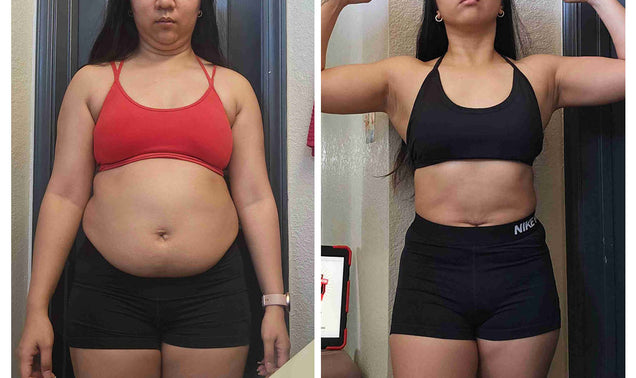When you first start working out, you are going to have many questions, including, "How many exercises per muscle group?"
Like many things in life, the answer isn't one-size-fits-all. It varies based on several factors, including fitness level, goals, injury history, and lifestyle.
The good news is that no matter how much (or little) time you have to exercise, you can get results!
So, whether you’re looking to build lean muscle, lose body fat, work from home, or work 50-hours -- we’re going to give you the information you need to know to make the best decision for how many exercises per muscle group you should do.
How Many Sets Per Muscle Group Should You Do?
If you’re serious about building lean muscle and strength, exercise scientists and fitness experts recommend individuals perform 10-20 “hard sets” per muscle group each week.[1,2,3,5]
A “hard set” is defined as one where are within 1-2 reps of muscular failure (or the point at which you can no longer perform another rep under control).
Now, what if you’re a busy professional, full-time student, etc. and don’t have time to perform 10-20 hard sets per muscle group each week?
The good news is that research shows that you can still get good results with as little as 5 “hard sets” per muscle group each week.[5]
On the flip side, what if you have extra time and want to train more?
Well, research shows that there is a dose-response relationship between training volume and muscle growth, which means that more volume generally leads to greater muscle growth. In fact, some studies find that even better results are obtained with 45-52 sets per week![4,6]
Some Important Caveats Regarding Training Volume…
Just because there is a small body of research showing that very high volume training (>20-25 sets per muscle group per week) yields better hypertrophy, that doesn’t mean it’s suitable for every one of us that hits the gym.
For starters, you need to consider your training experience. If you’re new to the gym or coming back from a long layoff, then your muscles will respond very well to lower volumes. As such, there’s no need to perform a crazy amount of sets each week when you can get equal (or better) results from much lower volumes. Not only will you save time in the gym, but you’ll also reduce the likelihood of overuse injuries or accumulating excessive fatigue.
Second, you need to consider how hard you are training (i.e. intensity). If you’re not taking each set close to failure (1-2 reps short of failure), then doing a lot of extra sets won’t offer nearly the benefit that it potentially could. In essence, you’re performing “junk volume” -- doing more for the sake of doing more, but not really getting better results than simply making every set count.
Third, how is your sleep, nutrition, and stress management? If you have a low stress job, no young children, and sleep 7-9 hours each night, then you are in a much better situation to perform higher volume training routines than someone who works 50 hours, is married, has 3 young kids, and doesn’t sleep much. Exercise is a powerful stressor (albeit incredibly beneficial) to the body, but our body can only handle so much stress before it can’t adequately recover. Overstressing your body leads to injury, illness, and a lack of results.
Fourth, how much time do you have to dedicate to training? Similar to the previous scenario, individuals without a lot of professional, personal, and social obligations have more time to train. As such, they can experiment with higher volume training routines. For those with limited time to hit the gym, you’re better off performing a lower number of sets with greater intensity (aka training close to failure) and using the other time to prioritize family, nutrition, stress management, and recovery.
The Main Takeaway on How Many Sets Per Week
For the average fitness enthusiast looking to add some lean muscle, gain strength, and shed body fat, they are best served by performing 10-20 “hard sets” per muscle group per week. While research shows that performing more sets than 20 per week may be beneficial, the number of studies is small, and (for most of the general population) he/she doesn’t have the time to dedicate to that amount of training and recovery.
If you’re new to the gym, start on the lower end of that range and assess your progress. If you’re getting great results with 10 sets per week, that’s great! You don’t need to rush to higher volume training sessions.
On the other hand, if you’ve been training for several years and struggling to bust a plateau, then try adding a few extra sets for a particular training cycle and see how your body responds.
And, if you are pressed for time and can only get in ~5 hard sets per muscle group per week, realize you’re still going to build muscle and reshape your body, it just may take a little bit longer to see those changes compared to performing 10-20 sets per muscle per week.
Now that we’ve covered how many sets per muscle group per week you should do to build muscle, let’s now discuss how to spread those out across the week.
How Many Exercises Per Muscle Group Should I Do Per Week?
The answer to this question (again) is based on a number of factors, but generally speaking, you’ll want to perform between 2-4 exercises per muscle group each week. This offers three key benefits:
- It helps train a muscle group from a variety of angles and resistance profiles, which allows for better overall muscle tone and definition.
- It helps limit overuse injuries by stressing your muscles, ligaments, joints, and connective tissue from different angles.
- It keeps training fresh and engaging, which keeps you more motivated to push hard and prevents your workouts from becoming stale.
For example, let’s say you’re training each muscle group with 12 hard sets per week following a 3x per week total body training session. Dividing this amount of volume across your workouts could look like:
Monday
- Chest: Low Incline Dumbbell Press 4 x 8-10
- Back: Chest Supported Dumbbell Row 4 x 8-10
- Shoulders: Lateral Raise 4 x 12-15
- Quads: Leg Extension 4 x 12-15
- Hamstrings: Seated Leg Curls 4 x 12-15
- Biceps: Dumbbell Curls 3 x 10-12
- Triceps: Lying Triceps Extensions 3 x 10-12
Wednesday
- Quads: Leg Press 4 x 8-10
- Hamstrings: RDL 4 x 8-10
- Shoulders: Overhead Press 4 x 8-10
- Back: Pulldowns 4 x 10-12
- Chest: Chest Fly 4 x 12-15
- Biceps: Cable Curl 3 x 12-15
- Triceps: Triceps Pushdown 3 x 12-15
Friday
- Back: Barbell Row 4 x 6-8
- Chest: Bench Press 4 x 6-8
- Shoulders: Rear Delt Fly 4 x 12-15
- Quads: Bulgarian Split Squat 4 x 8-10/leg
- Hamstrings: Lying Leg Curl 4 x 8-10
- Biceps: EZ Bar Curl 3 x 8-10
- Triceps: EZ Bar Skullcrushers 3 x 8-10
Keep in mind that this is a 3x per week total body workout program. If you switch to an upper/lower or body part split, then how many sets and exercises per workout you do per muscle group will change.
Selecting the Best Workout Split
There are many effective workout splits, including full body, upper/lower, push/pull/legs, and body part split (aka “the bro split”). Each one has its benefits, but understand that there is no one “best” workout split.
It depends on your goals, lifestyle, personal preferences, etc.
What we can say is that if you can only train 2-3 times per week, then you’re best served by performing a total body split as this will allow you to hit all your body’s major muscle groups multiple times per week, which has been shown in research to offer better results.
If you have more time to train, then you can experiment with:
- Full body (using higher volumes)
- Upper/lower (which usually is 4 days per week)
- Push/Pull/Leg (which can be 3-6 days per week)
- Body Part Split (usually 4-5 days per week)
The number of exercises per body part will still (usually) be 2-4.
Can I Work Out Every Day?
Many new gym goers wonder if they can work out every day, or if it’s necessary to get results.
The good news is that: NO, you don’t need to hit the gym everyday to lose fat, build muscle, get results, etc.
Lifting weight just 2-3 times per week can yield dramatic results…if you push yourself during your workouts and aren’t messing around on your phone.
Remember, working out is when we’re expending energy, burning fat, and breaking down muscle tissue. It’s the minutes, hours, and days after your workout when your body rebuilds, recovers, and improves. That’s one of the reasons we stress the importance of post workout supplementation and developed Pure Rebuild.
After a workout, your energy reserves are depleted and your muscle fibers are broken down. Pure Rebuild provides key nutrients including essential amino acids (EAAs), creatine, glutamine, and electrolytes, and a highly bioavailable format that supports quicker recovery, hydration, and results.
That being said, if you have extra time, you can exercise more frequently, so long as those activities don’t interfere with your recovery or hinder your ability to push hard in your subsequent resistance training workouts. Some of our favorite “off day” activities to do outside of the gym include walking, hiking, yoga, cycling, or swimming.
The Bottom Line
How many exercises per muscle group you should do is individual. It’s based on your preferences, goals, and time you have to train. Generally speaking, you should include between 2-4 exercises per muscle group each week. The more advanced you are, the more exercise variation you can include.
If you’re a beginner (or coming back after a long layoff), then you’re best bet is to focus on a smaller number of exercises and get really good (proficient) at those so that you can focus on progressive overload (the primary driver of results) rather than training your nervous system to learn a new exercise.
And, if you’re confused about how to structure your workout program, don’t worry!
We’ve got you covered.
The 1UP Fitness App is a total game changer for anyone in your position.
We’ve simplified the process of getting results so you can focus on putting in the work and worrying about how many calories you should eat, what exercises you should do, how much water you should drink, etc.
Inside the app, you’ll have access to every tool and resource you need to be successful…for FREE!
You’ll be able to get customized workout plans and calorie recommendations catered to your goals and preferences. You’ll also find an extensive exercise library so if you’re not sure how to perform a certain workout or need a quick refresher, we’ve got you!
At the end of the day, whether you’re performing 3 exercises per muscle or 30, focus on making every set count -- push yourself, challenge your muscles, and you will find success!
References
- Krzysztofik M, Wilk M, Wojdała G, Gołaś A. Maximizing Muscle Hypertrophy: A Systematic Review of Advanced Resistance Training Techniques and Methods. Int J Environ Res Public Health. 2019 Dec 4;16(24):4897. doi: 10.3390/ijerph16244897. PMID: 31817252; PMCID: PMC6950543.
- Schoenfeld BJ, Ogborn D, Krieger JW. Dose-response relationship between weekly resistance training volume and increases in muscle mass: A systematic review and meta-analysis. J Sports Sci. 2017 Jun;35(11):1073-1082. doi: 10.1080/02640414.2016.1210197. Epub 2016 Jul 19. PMID: 27433992.
- Heaselgrave, S. R., Blacker, J., Smeuninx, B., McKendry, J., & Breen, L. (2019). Dose-Response Relationship of Weekly Resistance-Training Volume and Frequency on Muscular Adaptations in Trained Men. International Journal of Sports Physiology and Performance, 14(3), 360–368. https://doi.org/10.1123/ijspp.2018-0427
- Schoenfeld BJ, Contreras B, Krieger J, et al. Resistance Training Volume Enhances Muscle Hypertrophy but Not Strength in Trained Men. Med Sci Sports Exerc. 2018;51(1):94-103.
- Radaelli, R., Fleck, S. J., Leite, T., Leite, R. D., Pinto, R. S., Fernandes, L., & Simao, R. (2015). Dose-response of 1, 3, and 5 sets of resistance exercise on strength, local muscular endurance, and hypertrophy. Journal of Strength and Conditioning Research, 29(5), 1349–1358. https://doi.org/10.1519/JSC.0000000000000758
- ENES, ALYSSON1; DE SOUZA, EDUARDO O.2; SOUZA-JUNIOR, TÁCITO P.1. Effects of Different Weekly Set Progressions on Muscular Adaptations in Trained Males: Is There a Dose–Response Effect?. Medicine & Science in Sports & Exercise 56(3):p 553-563, March 2024. | DOI: 10.1249/MSS.0000000000003317
- Haun, C. T., Vann, C. G., Mobley, C. B., Roberson, P. A., Osburn, S. C., Holmes, H. M., Roberts, M. D. (2018). Effects of Graded Whey Supplementation During Extreme-Volume Resistance Training . Frontiers in Nutrition . Retrieved from https://www.frontiersin.org/article/10.3389/fnut.2018.00084






